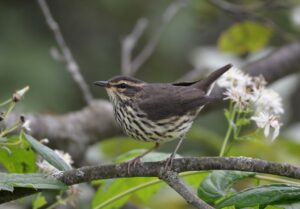Get To Know This Year’s Featured World Migratory Bird Day Species: Northern Waterthrush

Vital Signs
Common name: Northern Waterthrush
Latin name: Parkesia noveboracensis
Anishinaabemowin name: Ozaawibineshii/Bineshiins7 (Warblers)
Range: The Northern Waterthrush can be found most abundantly in Canada’s northern forest along lakes and rivers, and in bogs and swamps during their breeding season. It has a breeding range that stretches from Newfoundland to the west coast of Canada, touching most provinces and territories, but not Nunavut1. Migration happens at night, where these birds travel north to Canada from Central America and northern South America2 in the spring, and reverse this pattern in the late summer and fall.
Average Lifespan: 8.9 years3.
Size: Length of 12 to 14 cm with a wingspan of 22.5 to 25.5 cm, typically weighs 14.7 to 19.2 g4
Canadian population estimate: 5,000,000-50,000,000 adults1
The Facts
The Northern Waterthrush is part of the warbler family; it is a larger warbler that has a relatively long, heavy bill and a flat head2. Both the males and females of this population look alike. They are dark brown on their top half and buff-white with darker streaks on their lower side. It possesses a distinct pale yellowish line that extends from its beak to the back of its head, passing just over the eye. Its wings and tails appear to look dark brown from above2.
Northern Waterthrush is very similar to Louisiana Waterthrush, which breeds in extreme southern Ontario6 and Quebec, and which is the only other species in the genus Parkesia. The Northern Waterthrush prefers areas close to bodies of water. During the winter, the species can be found in the tropical mangroves of Central and South America3.
These birds often nest in small, hollow, moss-covered stumps, typically close to water5. The females will usually lay 4-5 eggs, which take 12-13 days to incubate. These young birds will leave the nest approximately 10 days after hatching and can fly about a week later5.
The Story
The Breeding Bird Survey which has studied North American Breeding Birds and their distribution from 1970-2016 suggests that populations have increased since the 1970’s but poor coverage of the northern portion of the breeding range reduces the reliability of these data1. The population of Northern Waterthrush is considered to be stable and of low management concern, primarily within their breeding locations across Canada. However, due to human activities on their winter range in the mangrove forests of Mexico, there has been an increased risk of their migrating population declining2.
Also, despite degradation of habitat and pesticide threats, Northern Waterthrush populations remain stable. Climate change models also predict declines in Northern Waterthrush populations. National Audubon predicts a net loss of seven percent in its range based on a two-degree temperature rise, and a 22 percent loss based on three degrees increase4. As the Northern Waterthrush is a resident of the boreal forest primarily, an area where warming is predicted to be more severe than many other areas, these scenarios are very real and possible.
What you can do
Though currently the population is stable globally, these birds could be sensitive to habitat loss, pesticides, as well as the ongoing effects of climate change. Drainage of swamps for agricultural and wetland development will reduce the breeding habitat for these birds. As well as spraying of pesticides, such as aerial spraying for the spruce budworm can kill these birds directly, and reduce the biomass of their prey3. Climate change threatens to dramatically shrink the species range based on scenarios of two or more degrees of average temperature increase.
All things considered, advocating for the conservation of wetlands and swamps in Canada, as well as the reduction of the use of aerial pesticides, and conserving nature, in general, are great ways you can help to support the Northern Waterthrush. Supporting efforts to fight climate change and reduce global warming are other ways of helping the Northern Waterthrush.
You can also get involved with a local Bird Team in your community to work towards becoming Bird Friendly City Certified or host and participate in an upcoming World Migratory Bird Day event near you! You can also contact your City Council and urge them to join cities like Vaughan, Barrie, and Vancouver, to proclaim their support of World Migratory Bird Day.
Sources:
1 Environment and Climate Change Canada. 2019. Northern Waterthrush (Parkesia noveboracensis)
https://wildlife-species.canada.ca/bird-status/oiseau-bird-eng.aspx?sY=2019&sL=e&sM=a&sB=NOWA#:~:text=The%20Northern%20Waterthrush%20is%20an,east%20to%20the%20west%20coast
2 Seattle Audubon Society, 2021. https://birdweb.org/birdweb/bird/northern_waterthrush
3 Harris, M. 1999. “Seiurus noveboracensis” (On-line), Animal Diversity Web. https://animaldiversity.org/accounts/Seiurus_noveboracensis/ https://animaldiversity.org/accounts/Seiurus_noveboracensis/#lifespan_longevity
4 The Cornell Lab. 2023. All About Birds, Northern Waterthrush. https://www.allaboutbirds.org/guide/Northern_Waterthrush/id
5 Audubon. Guide to North American Birds, Northern Waterthrush. https://www.audubon.org/field-guide/bird/northern-waterthrush
6 Ministry of the Environment, Conservation and Parks. 2014. https://www.ontario.ca/page/louisiana-waterthrush#:~:text=In%20Canada%2C%20the%20Louisiana%20waterthrush,there%20has%20never%20been%20confirmed
7 Riddell, C. 2019. An Anishinaabe Ethno-ornithology of Wabaseemoong Independent Nations. Ridell Faculty of Environment, Earth, and Resources. Natural Resources Institute, University of Manitoba. https://www.umanitoba.ca/institutes/natural_resources/pdf/2020/Masters%20Thesis%20Rempel%202020.pdf
This project was undertaken with the financial support of the Government of Canada through the federal Department of Environment and Climate Change.
Ce projet a été réalisé avec l’appui financier du gouvernement du Canada agissant par l’entremise du ministère fédéral de l’Environnement et du Changement climatique.




